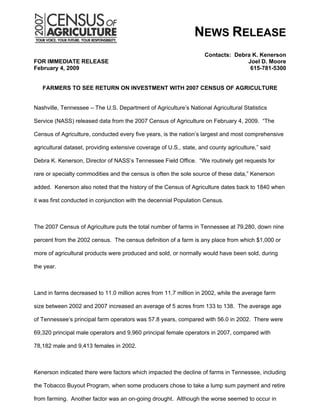
2007 census results
- 1. NEWS RELEASE Contacts: Debra K. Kenerson FOR IMMEDIATE RELEASE Joel D. Moore February 4, 2009 615-781-5300 FARMERS TO SEE RETURN ON INVESTMENT WITH 2007 CENSUS OF AGRICULTURE Nashville, Tennessee – The U.S. Department of Agriculture’s National Agricultural Statistics Service (NASS) released data from the 2007 Census of Agriculture on February 4, 2009. “The Census of Agriculture, conducted every five years, is the nation’s largest and most comprehensive agricultural dataset, providing extensive coverage of U.S., state, and county agriculture,” said Debra K. Kenerson, Director of NASS’s Tennessee Field Office. “We routinely get requests for rare or specialty commodities and the census is often the sole source of these data,” Kenerson added. Kenerson also noted that the history of the Census of Agriculture dates back to 1840 when it was first conducted in conjunction with the decennial Population Census. The 2007 Census of Agriculture puts the total number of farms in Tennessee at 79,280, down nine percent from the 2002 census. The census definition of a farm is any place from which $1,000 or more of agricultural products were produced and sold, or normally would have been sold, during the year. Land in farms decreased to 11.0 million acres from 11.7 million in 2002, while the average farm size between 2002 and 2007 increased an average of 5 acres from 133 to 138. The average age of Tennessee’s principal farm operators was 57.8 years, compared with 56.0 in 2002. There were 69,320 principal male operators and 9,960 principal female operators in 2007, compared with 78,182 male and 9,413 females in 2002. Kenerson indicated there were factors which impacted the decline of farms in Tennessee, including the Tobacco Buyout Program, when some producers chose to take a lump sum payment and retire from farming. Another factor was an on-going drought. Although the worse seemed to occur in
- 2. late summer and into the fall of 2007, Tennessee had experienced worsening conditions for several years prior. A number of our smaller farms, which are livestock producers, had a lack of grazing and water supplies. When this was coupled with rising feed and other input costs, it resulted in liquidation of herds or a reduction in numbers that no longer qualified those operations as farms. Census results are available online and in various publications to be issued by NASS. For more information, visit www.agcensus.usda.gov or call (800) 727-9540. ###
